
How Much Editing Was Done to Emily Dickinson's Poems After She Died?
The Poet's Earliest Advocates Might Have Been Guilty of Overreach
Before Emily Dickinson died in 1886, her sister Lavinia promised that she would burn Emily’s papers. But when she discovered a cache of almost 1,800 poems that her sister had written, Lavinia instead sought to find someone who could help bring this unique poetry to the world. That person turned out to be Mabel Loomis Todd.
Todd, the beautiful, young and energetic wife of an Amherst College professor, had literary ambitions of her own. She also was peculiarly entwined with members of the Dickinson family, including an intense and passionate extra-marital relationship with Emily and Lavinia’s older brother, Austin. Lavinia (also known as Vinnie) sensed that Mabel would be willing to take on the task of preparing Emily’s poetry for publication. She was right.
But what Lavinia did not realize was the extent of work needed to get the poems into a form in which they could be considered worthy of publication in the late 19th century. These excerpts from my forthcoming book, After Emily: Two Remarkable Women and the Legacy of America’s Greatest Poet, delineate the complicated process Mabel undertook. Her arduous work led to the publication of three volumes of Dickinson’s poetry, but also had some unintended consequences—including a scandalous lawsuit that rocked the community, the sequestration of more than 600 original Dickinson poems for three decades, and ultimately, the division of Dickinson’s manuscripts between Harvard University and Amherst College. It also led to upending the career path of Mabel’s accomplished daughter, Millicent Todd Bingham, who took on her mother’s work, and to exacerbating the deep tensions between Mabel and Millicent.
And in the 128 years since the publication of the first volume of Dickinson’s poetry, it’s brought considerable debate over the editorial choices that they made.
Today these debates continue. Looking at Dickinson’s original manuscripts and Todd’s original transcriptions of them, we can clearly see ways in which Todd and Colonel Thomas Wentworth Higginson (the well-known abolitionist, Civil War hero and 19th-century literary advocate whom she convinced to join her in the editing project for the first two volumes of poetry published in 1890 and 1891) altered words, changed capitalization and punctuation and perhaps most controversially, gave titles to poems that originally bore none. And yet it is clear that without the work of Mabel Loomis Todd and later, Millicent Todd Bingham, the world might never have known the poetry of Emily Dickinson.
![]()
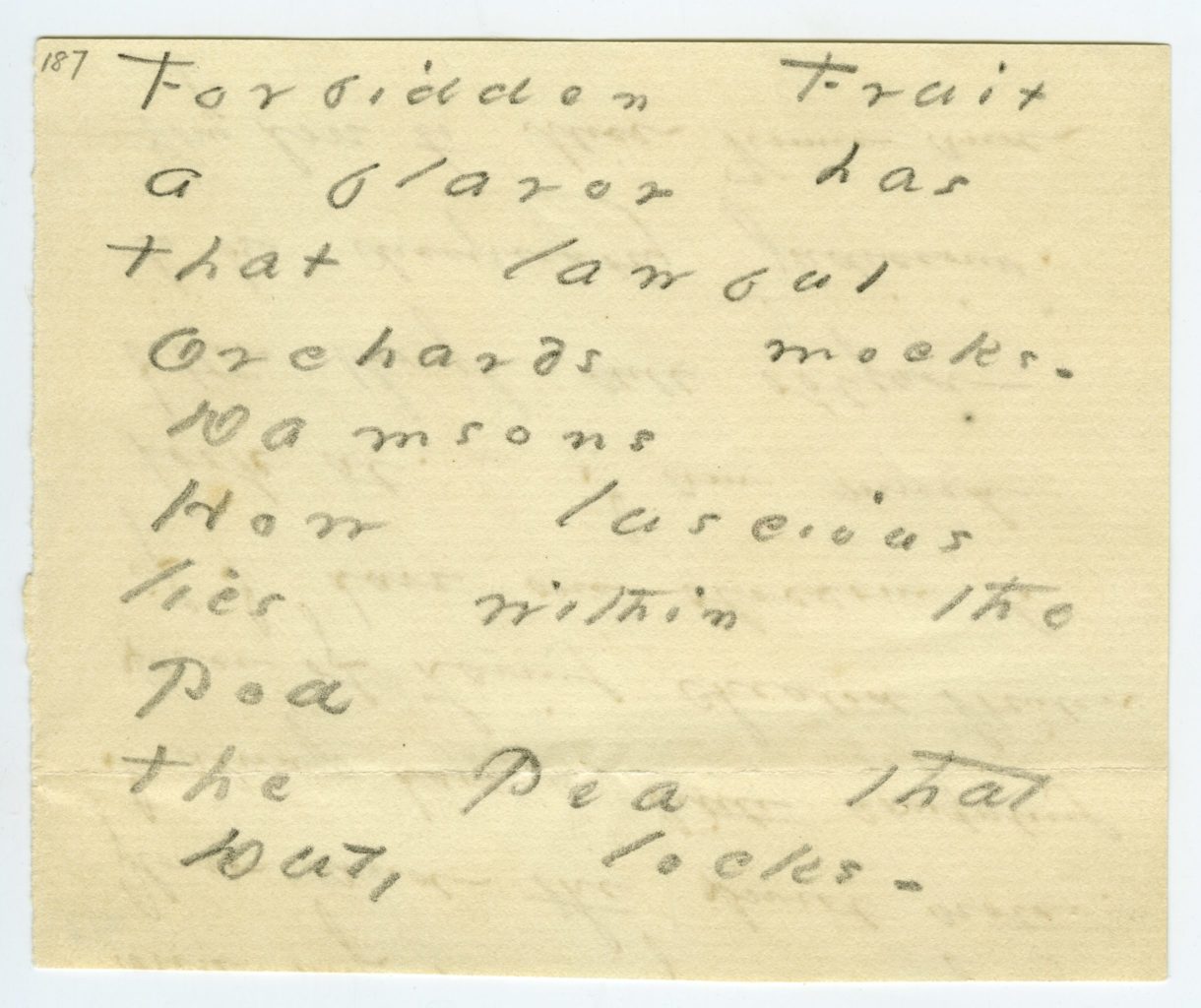 Dickinson’s handwritten version of the poem that would later be titled “Forbidden Fruit.” Courtesy of the Amherst College Collection.
Dickinson’s handwritten version of the poem that would later be titled “Forbidden Fruit.” Courtesy of the Amherst College Collection.
 Mabel Loomis Todd’s transcription of “Forbidden Fruit,” a poem first published in 1896. Todd sometimes used different words than what Dickinson had suggested, altered her punctuation, and gave titles to poems that did not originally have one. Courtesy of the Amherst College Collection.
Mabel Loomis Todd’s transcription of “Forbidden Fruit,” a poem first published in 1896. Todd sometimes used different words than what Dickinson had suggested, altered her punctuation, and gave titles to poems that did not originally have one. Courtesy of the Amherst College Collection.
![]()
Mabel recalled that when she first took the box of poems, “The outlook was appalling. Emily wrote in the strangest hand ever seen, which I had to absolutely incorporate into my innermost consciousness before I could be certain of anything she reflected.” Mabel also noted the difficulties she had because Emily often wrote “six or eight” different words she was considering using in a particular point in a poem, with additional choices that “would run around the margins.” In her 1930 Harper’s Magazine article, Mabel wrote, “In the so-called ‘copied poems,’ tiny crosses written beside a word which might be changed ultimately and which referred to scores of possible words at the bottom of the page were all exactly alike, so that only the most sympathetic and at-one-with-the-author could determine where each word belonged.”
Mabel might not have been Vinnie’s first choice of an editor, but it turned out that she was an inspired one. Mabel worked diligently and methodically on the poems, sometimes for hours each day to decipher, interpret and transcribe them. She called David and even seven-year-old Millicent into service to help. (Looking back, Millicent reflected, “Initiation into the vagaries of Emily’s handwriting is one of the earliest rites I can recall.”) After laboriously copying different versions of each poem by hand, Mabel would type them up on her new borrowed Hammond typewriter. When she was more comfortable with the machine, Mabel sometimes typed poems without first copying them by hand.
![]()
 Mabel Loomis Todd’s transcription of “Daily Bliss.” The poem first appeared in print in 1896. Courtesy of the Amherst College Collection.
Mabel Loomis Todd’s transcription of “Daily Bliss.” The poem first appeared in print in 1896. Courtesy of the Amherst College Collection.
![]()
Mabel arranged for a meeting with Colonel Higginson, determined to show him a large pile of copied poems. She brought with her the “immense file” that “weighed many pounds.”
“He did not think a volume advisable,” Mabel wrote in 1890. “They were crude in form, he said, and the public would not accept even fine ideas in such rough and mystical dress—so hard to elucidate.” But certain of the poems’ worth and determined to convince Higginson to sign onto the project, Mabel “read him nearly a dozen of my favorites—and he was greatly astonished—said he had no idea there were so many in passably conventional form.” Emily’s “strange cadences” came alive when Mabel read them aloud.
Higginson asked Mabel if she would classify the poems into three groups (A, B and C), organized by her own judgment of which were the best ones (“not only those of most original thought, but expressed in the best form”), a second group of poems “with striking ideas, but with too many of her peculiarities of construction to be used unaltered for the public” and a third group that she “considered too obscure or too irregular in form for public use, however brilliant and suggestive.” If she did that, Higginson said that he would look more carefully at the categorized poems during the winter months. Mabel was thrilled, though from the distance of many years later, noted she believed Higginson had not initially exuded confidence: “he indicated to me my herculean task, and I began alone.”
After Higginson agreed to assist with the project, Mabel stepped up her efforts to get the rest of the poems classified. She worked quickly and sent Higginson her selections on November 18th. He responded a week later, saying, “I can’t tell you how much I am enjoying the poems. There are many new to me which take my breath away & which also have form beyond most of those I have ever seen before. . . . My confidence in their availability is greatly increased & it is fortunate there are so many because it is obviously impossible to print all & this leaves the way open for careful selection.” He suggested that among the poems Mabel selected in her first category, some were more worthy of publication than others. Further, he posited arranging the subset of poems thematically: those about life, those about nature, and those about time, death and eternity.
![]()
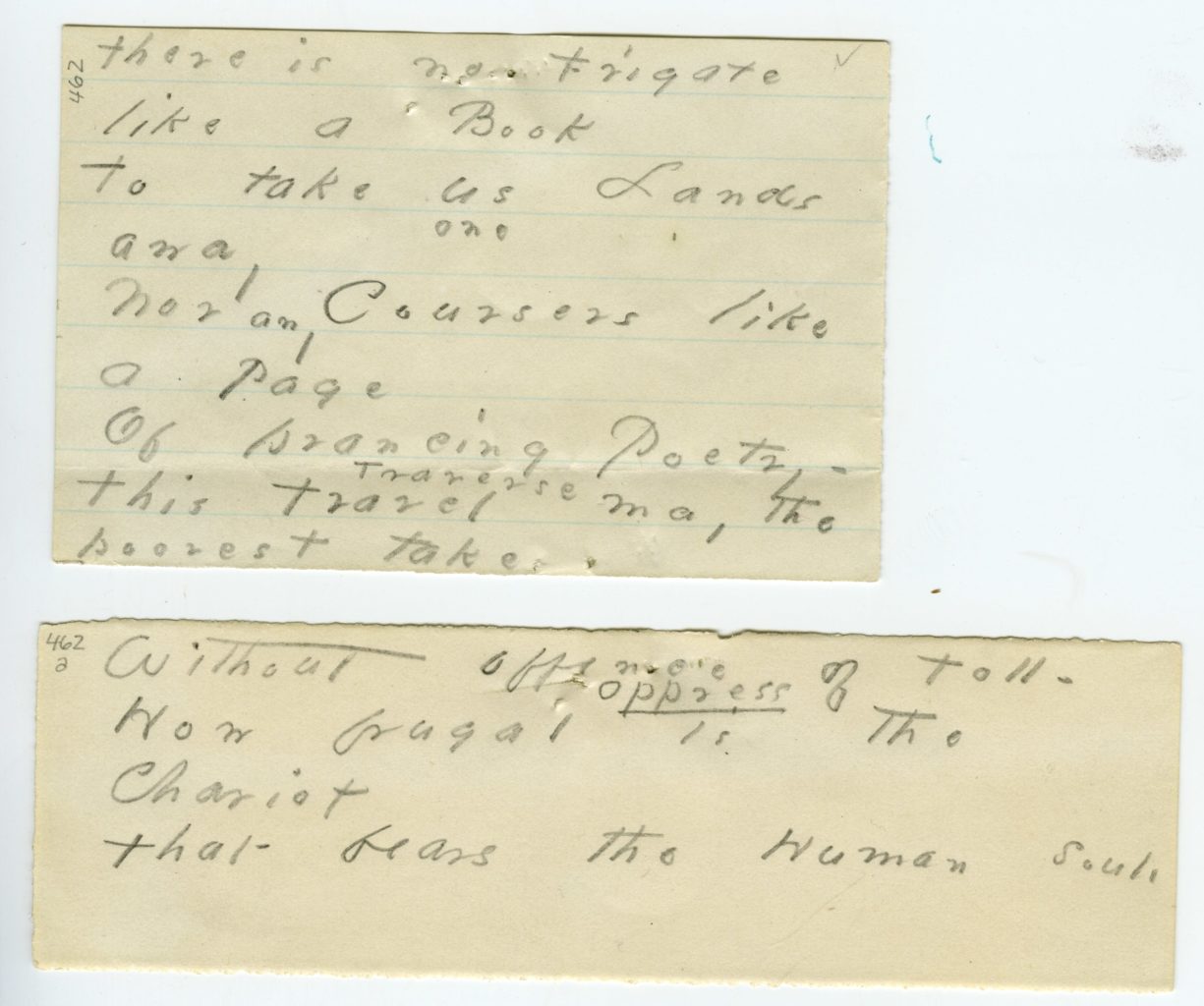 Dickinson’s handwritten manuscript of “There Is No Frigate Like a Book.” Courtesy of the Amherst College Collection.
Dickinson’s handwritten manuscript of “There Is No Frigate Like a Book.” Courtesy of the Amherst College Collection.
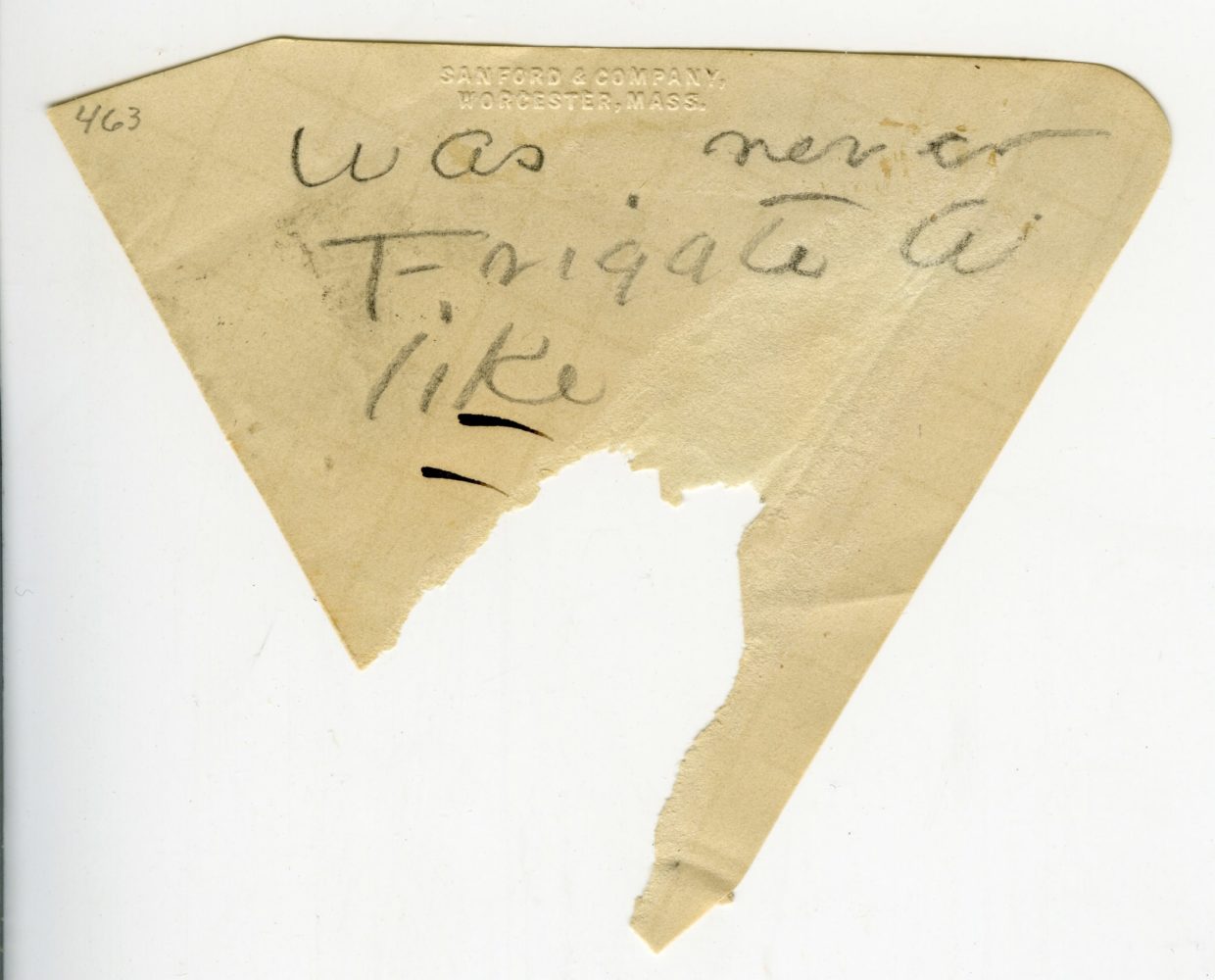 An envelope scrap with marginalia for “There Is No Frigate Like a Book.” Courtesy of the Amherst College Collection.
An envelope scrap with marginalia for “There Is No Frigate Like a Book.” Courtesy of the Amherst College Collection.
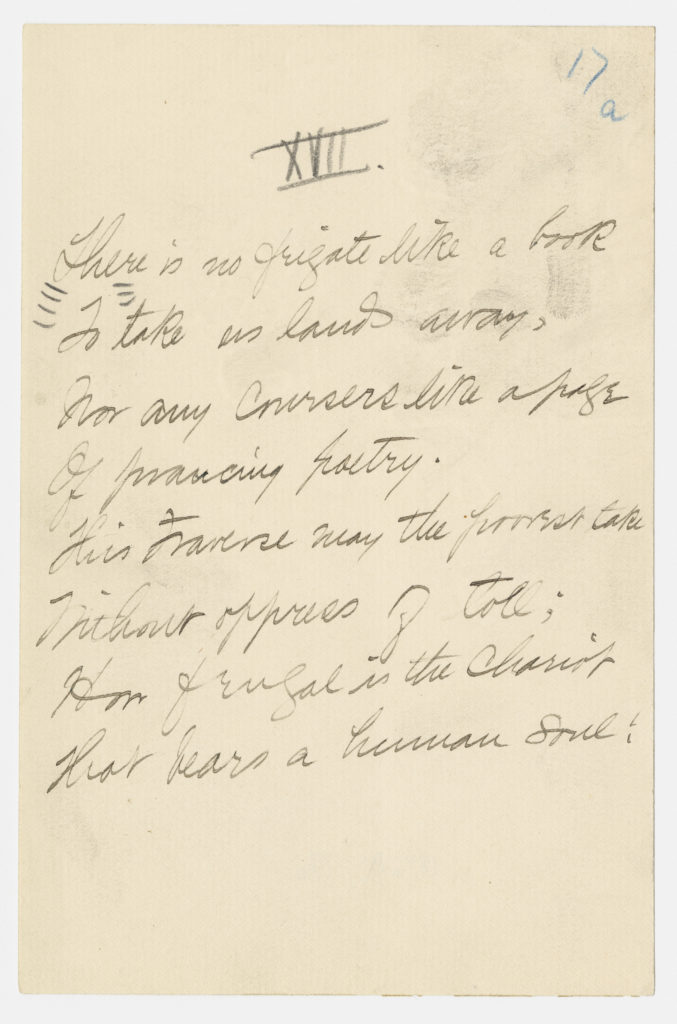 Mabel Loomis Todd’s transcription of “There is No Frigate Like a Book.” Courtesy of the Amherst College Collection.
Mabel Loomis Todd’s transcription of “There is No Frigate Like a Book.” Courtesy of the Amherst College Collection.
![]()
“Emily placed a great responsibility upon her editors by leaving to them so often the choice of a key word. For it authorized them to color her thought with their taste. Obliged so often to make a choice, they might be tempted to go further, to change a word to fit their own preference—a dangerous leeway, for the thought is timeless while taste may change,” Bingham wrote in Ancestors’ Brocades. Millicent also made clear that even when her mother altered Emily’s word choice, these were decisions not made easily. According to Millicent, her mother seemed aware that in compromising with Higginson’s view of what might be acceptable, she might also have undermined Emily’s poetic intent.
In addition to altering words, Mabel and Higginson made other textual changes. Among other things, they sometimes altered words to make lines rhyme and conform to a more typical a-b-c-b rhyming pattern.
They also changed what Millicent deemed “grammatical vagaries” or “Emily’s grammatical irresponsibility”—including swapping out “he” for “him” and “she” for “her” in some poems. Several more recent scholars suggested that Emily’s grammar might have reflected spoken usage of the day rather than written usage, though this is not certain. Others posit that Emily’s pronoun use might have been deliberate and its suggestiveness in tying “she” with sensual imagery rather than “her” was something Mabel and Higginson purposively sought to change to make the poems more acceptable to potential readers.
*
Few of Mabel’s and Higginson’s decisions have drawn more ire than the decision to title poems that originally bore no name. Emily herself gave titles to only a few of what proved to be nearly eighteen hundred poems. Scholar John Mulvihill suggests that Emily left the vast majority of her poetry untitled both because she did not publish it, and thus had no need to yield to this convention, and also because titling poems tends to draw a reader’s attention to a particular image or interpretation. “Left untitled, one can argue, a poem can more simply be, or seem to be.”
Mabel had reservations about titling the poems. In 1890 she wrote that while Higginson wanted to put titles on the poems, “I do not believe, myself, in naming them; and although I admire Mr. Higginson very much, I do not think many of his titles good.” Mabel thought that Higginson was often off base with his titles, and that a title such as “A World Well Lost” for the poem that began “I lost a world the other day, / Has anybody found?” completely misrepresented Emily’s thought.
Contemporary practice for the identification of Emily’s poetry is to utilize the numerical system devised by Johnson in the 1950s, along with the poem’s first line rather than use a particular title, or to use the numerical system Franklin established in the late 1990s in his chronologically arranged three-volume edition of the complete poems utilizing newer methods of dating the poems. This is a decision Mabel probably would have embraced. But Mabel yielded to Higginson on the titling of the poetry, as she did on other editorial decisions. As Millicent explained, “My mother was ready to accept as final Colonel Higginson’s judgment regarding the poems. Though a lesser figure he had been coeval with the greatest and that sufficed.” For Mabel, his judgment trumped her own, even though she often retained and recorded her own opinions. As literary scholar Elizabeth Horan points out, while Mabel “maintained all her prerogatives as a ‘lady,’ she got her way because she willingly deferred to men. . . . She was careful not to appear pushy and to take others’ interests into account when she proposed new lines of action.”
*
Poems, by Emily Dickinson, was published on November 12th, 1890. Roberts Brothers did an initial press run of 480 copies. Mabel was sent six copies, and she later told Millicent, “The sense of actually holding it in our hands was one of exultation.” But, as Millicent noted, with the publication of this volume, “A great calm seems to have enveloped them all—an oppressive quiet, like the eye of the storm.”
__________________________________
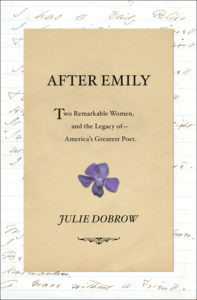
Adapted from After Emily: Two Remarkable Women and the Legacy of America’s Greatest Poet. Used with the permission of W.W. Norton & Company. Copyright © 2018 by Julie Dobrow.
Julie Dobrow
Julie Dobrow is a professor at Tufts University and serves as director of the Center for Interdisciplinary Studies. Her writing has appeared in Boston Globe Magazine and The Huffington Post, among other publications. Her biography of Mabel Loomis Todd and Millicent Todd Bingham After Emily: Two Remarkable Women and the Legacy of America’s Greatest Poet, is out from W.W. Norton & Company. She lives outside of Boston.












